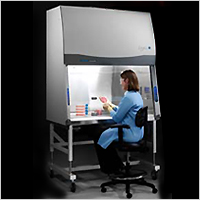Fume cabinets are highly versatile and can be used in biological, medical or pharmaceutical, biochemical and research applications. The main objective of using a fume cabinet is to provide a standardized level of protection against contamination or exposure to unwanted aerosols inside and outside of the hood workspace.
To avoid workers inhaling toxic fumes
In biochemical laboratories, some procedures will call for the use of dangerous chemicals that can omit toxic fumes. Fume cabinets help contain toxic gases and vapor from leaving the workspace. This makes handling such compounds easier, as lab technicians will not have to wear as much protective equipment or gas masks – which can be advantageous when working with toxic fumes for extended periods.
To protect the product or experiment
Laminar flow and biological hoods are designed to protect both products and experimental materials from pathogens and other contamination within the lab space and ambient air. A consistent positive pressure airflow controls this, keeping unfiltered air out with minimal effort while filtering all incoming air into the cabinet. This filtration is accomplished using high-end filters that can trap viruses, bacteria and other microbial contaminants from entering the workspace.
Not only does this help with the efficacy of an experiment, but it also allows for significantly less use of materials as you will not have to account for as high of a failure rate in products like culture plates.
To protect the environment (recirculating fume hoods and other biosafety hoods are fitted with appropriate filters in the exhaust airstream)
Some fume hoods will incorporate recirculating systems for airflow, reducing the exhaust output into the environment. A number of filters can also be applied to the exhaust airstream that will minimize the environmental impact of releasing fumes or foreign compounds into the air outside.






